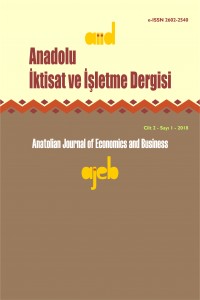Araştırma Makalesi
Yıl 2018,
Cilt: 2 Sayı: 1, 38 - 55, 24.04.2018
Öz
Toplam talep şoklarının varyansı ile enflasyon-çıktı ödünleşme
parametresi arasındaki negatif ilişki Lucas değişkenlik hipotezi olarak
adlandırılmaktadır. Bu çalışmada Lucas
değişkenlik hipotezinin 1982-2005 dönemi itibariyle Türkiye için dönemsel
parametreler yoluyla test edilmesi amaçlanmaktadır. Ayrıca çalışmada Froyen ve
Waud (1984) modeli ile arz şoklarının reel değişkenler üzerindeki etkisi de
incelenmiştir. Çalışmada elde edilen sonuçlara göre ele alınan dönemler
itibariyle arz şokları talep şoklarına göre reel değişkenler üzerinde daha
büyük bir etkiye sahiptir
Anahtar Kelimeler
Kaynakça
- Alberro, J. (1981), “The Lucas Hypothesis on the Phillips Curve further International Evidence”, Journal of Monetary Economics, 7, 239-250.Arak, M. (1977), “Some International Evidence on Output-Inflation Tradeoffs: Comment”, The American Economic Review, 67, 728-730.Christenson, M., Paldam, M. (1991), “Shooting Fish in the Barrel? Examining the Standart Test of the Lucas Variability Hypothesis”, Applied Economics, 23, 1811-1818.Conway, R. K., Gill, G. (1991), “Is the Phillips Curve Stable? A Time Varying Parameter Approach”, Journal of Policy Modelling, 13(1), 141-151.Engle, R. F. (1982), “Autoregressive Conditional Heteroskedasticity with Estimates of the Variance of United Kingdom Inflation”, Econometrica, 50(4), 987-1007.Friedman, M. (1968), “The Role of Monetary Policy”, The American Economic Review, 58, 1-17. Froyen, R., Waud, R. N. (1984), “The Changing Relationship between Aggregate Price and Output: The British Experience”, Economica, 51, 53-67.Froyen, R., Waud, R. N. (1985), “Demand Variability, Supply Shocks and the Output-Inflation Tradeoff”, The Review of Economics and Statistics, 67, 9-15.Lucas, R. E. (1973), “Some International Evidence on Output-Inflation Tradeoffs”, American Economic Review, 63, 326-34.Kim, C., Nelson, R. C. (1989), “The Time Varying-Parameter Model for Modelling Changing Conditional Variance: The Case of the Lucas Hypothesis”, Journal of Business and Economics Statistics, 7, 433-440.Küçükkale, Y. (2000), Phillips Eğrisi Üzerine Lucas Değişkenlik Hipotezi, Yayınlanmamış Doktora Tezi.Parkin, M., Bentley, B., Fader, C. (1981), “Some International Evidence on Output-Inflation Trade-Offs: A Reappraisal,” in Development in an Inflationary World, eds. by Flanders, M. and A. Razin, New York: Academic Pres.Phelps, E. (1967), “Phillips Curves, Expectations of Inflation, and Optimal Inflation over Time”, Economica, 34, 254-281.Phillips, A.W. (1958), “The Relation between Unemployment and the Rate of Change of Money Wage Rates in the United Kingdom, 1861-1957”, Economica, 25, 283-299. White, H. (1980), “A Heteroskedasticity-Consistent Covariance Matrix Estimator and a Direct Test for Heteroskedasticity”, Economica, 25(100), 283-299.Yamak, R., Karahasan, N. (1995), “Lucas Değişkenlik Hipotezinin Türk Ekonomisi için Geçerliliği”, Dokuz Eylül Üniversitesi İktisadi İdari Bilimler Fakültesi Dergisi, 10, 71-77.Yamak, R., Küçükkale, Y. (1997), “Phillips Eğrisi Üzerine Lucas Değişkenlik Hipotezi” Ekonomik Yaklaşım Dergisi, 8, 259-282.
Yıl 2018,
Cilt: 2 Sayı: 1, 38 - 55, 24.04.2018
Öz
Kaynakça
- Alberro, J. (1981), “The Lucas Hypothesis on the Phillips Curve further International Evidence”, Journal of Monetary Economics, 7, 239-250.Arak, M. (1977), “Some International Evidence on Output-Inflation Tradeoffs: Comment”, The American Economic Review, 67, 728-730.Christenson, M., Paldam, M. (1991), “Shooting Fish in the Barrel? Examining the Standart Test of the Lucas Variability Hypothesis”, Applied Economics, 23, 1811-1818.Conway, R. K., Gill, G. (1991), “Is the Phillips Curve Stable? A Time Varying Parameter Approach”, Journal of Policy Modelling, 13(1), 141-151.Engle, R. F. (1982), “Autoregressive Conditional Heteroskedasticity with Estimates of the Variance of United Kingdom Inflation”, Econometrica, 50(4), 987-1007.Friedman, M. (1968), “The Role of Monetary Policy”, The American Economic Review, 58, 1-17. Froyen, R., Waud, R. N. (1984), “The Changing Relationship between Aggregate Price and Output: The British Experience”, Economica, 51, 53-67.Froyen, R., Waud, R. N. (1985), “Demand Variability, Supply Shocks and the Output-Inflation Tradeoff”, The Review of Economics and Statistics, 67, 9-15.Lucas, R. E. (1973), “Some International Evidence on Output-Inflation Tradeoffs”, American Economic Review, 63, 326-34.Kim, C., Nelson, R. C. (1989), “The Time Varying-Parameter Model for Modelling Changing Conditional Variance: The Case of the Lucas Hypothesis”, Journal of Business and Economics Statistics, 7, 433-440.Küçükkale, Y. (2000), Phillips Eğrisi Üzerine Lucas Değişkenlik Hipotezi, Yayınlanmamış Doktora Tezi.Parkin, M., Bentley, B., Fader, C. (1981), “Some International Evidence on Output-Inflation Trade-Offs: A Reappraisal,” in Development in an Inflationary World, eds. by Flanders, M. and A. Razin, New York: Academic Pres.Phelps, E. (1967), “Phillips Curves, Expectations of Inflation, and Optimal Inflation over Time”, Economica, 34, 254-281.Phillips, A.W. (1958), “The Relation between Unemployment and the Rate of Change of Money Wage Rates in the United Kingdom, 1861-1957”, Economica, 25, 283-299. White, H. (1980), “A Heteroskedasticity-Consistent Covariance Matrix Estimator and a Direct Test for Heteroskedasticity”, Economica, 25(100), 283-299.Yamak, R., Karahasan, N. (1995), “Lucas Değişkenlik Hipotezinin Türk Ekonomisi için Geçerliliği”, Dokuz Eylül Üniversitesi İktisadi İdari Bilimler Fakültesi Dergisi, 10, 71-77.Yamak, R., Küçükkale, Y. (1997), “Phillips Eğrisi Üzerine Lucas Değişkenlik Hipotezi” Ekonomik Yaklaşım Dergisi, 8, 259-282.
Toplam 1 adet kaynakça vardır.
Ayrıntılar
| Birincil Dil | Türkçe |
|---|---|
| Konular | Ekonomi |
| Bölüm | Makaleler |
| Yazarlar | |
| Yayımlanma Tarihi | 24 Nisan 2018 |
| Yayımlandığı Sayı | Yıl 2018 Cilt: 2 Sayı: 1 |


